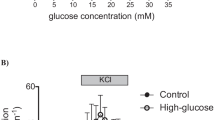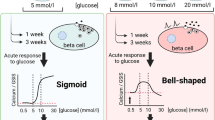Abstract
MIN6 cells and MIN6 pseudo-islets are popular surrogates for the use of primary beta cells and islets. Even though it is generally agreed that the stimulus-secretion coupling may deviate from that of beta cells or islets, direct comparisons are rare. The present side-by-side comparison of insulin secretion, cytosolic Ca2+ concentration ([Ca2+] i ) and oxygen consumption rate (OCR) points out where similarities and differences exist between MIN6 cells and normal mouse beta cells. In mouse islets and MIN6 pseudo-islets depolarization by 40 mM KCl was a more robust insulinotropic stimulus than 30 mM glucose. In MIN6 pseudo-islets, but not in mouse islets, the response to 30 mM glucose was much lower than to 40 mM KCl and could be suppressed by a preceding stimulation with 40 mM KCl. In MIN6 pseudo-islets, glucose was less effective to raise [Ca2+] i than in primary islets. In marked contrast to islets, the OCR response of MIN6 pseudo-islets to 30 mM glucose was smaller than to 40 mM KCl and was further diminished by a preceding stimulation with 40 mM KCl. The same pattern was observed when MIN6 pseudo-islets were cultured in 5 mM glucose. As with insulin secretion memory effects on the OCR remained after wash-out of a stimulus. The differences between MIN6 cells and primary beta cells were generally larger in the responses to glucose than to depolarization by KCl. Thus, the use of MIN6 cells in investigations on metabolic signalling requires particular caution.






Similar content being viewed by others
References
H.G. Coore, P.J. Randle, Regulation of insulin secretion studied with pieces of rabbit pancreas incubated in vitro. Biochem. J. 93, 66–78 (1964)
M. Erecinska, J. Bryla, M. Michalik, M. Meglasson, D. Nelson, Energy metabolism in islets of Langerhans. Biochim. Biophys. Acta 1101, 273–295 (1992)
U. Panten, H. Ishida, Fluorescence of oxidized flavoproteins from perifused isolated pancreatic islets. Diabetologia 11, 569–753 (1975)
A. Sener, W.J. Malaisse, Stimulation by d-glucose of mitochondrial oxidative events in islet cells. Biochem. J. 246, 89–95 (1987)
D.L. Cook, C.N. Hales, Intracellular ATP directly blocks K+ channels in pancreatic Beta-cells. Nature 311, 271–273 (1984)
F.M. Ashcroft, D.E. Harrison, S.J. Ashcroft, Glucose induces closure of single potassium channels in isolated rat pancreatic beta-cells. Nature 312, 446–448 (1984)
S.H. Gerber, T.C. Südhof, Molecular determinants of regulated exocytosis. Diabetes 51(Suppl. 1), S3–S11 (2002)
P. Rorsman, E. Renström, Insulin granule dynamics in pancreatic beta cells. Diabetologia 46, 1029–1045 (2003)
M. Welsh, C. Hellerström, A. Andersson, Respiration and insulin release in mouse pancreatic islets. Effects of l-leucine and 2-ketoisocaproate in combination with d-glucose and l-glutamine. Biochim. Biophys. Acta 721, 178–184 (1982)
U. Panten, H. Klein, O2 consumption by isolated pancreatic islets, as measured in a microincubation system with a Clark-type electrode. Endocrinology 111, 1595–1600 (1982)
U. Panten, M. Schwanstecher, A. Wallasch, S. Lenzen, Glucose both inhibits and stimulates insulin secretion from isolated pancreatic islets exposed to maximally effective concentrations of sulfonylureas. Naunyn-Schmiedebergs Arch. Pharmacol. 338, 459–462 (1988)
M. Gembal, P. Gilon, J.C. Henquin, Evidence that glucose can control insulin release independently from its action on ATP-sensitive K+ channels in mouse B cells. J. Clin. Invest. 1992(89), 1288–1295 (1992)
Y. Sato, J.C. Henquin, The K+-ATP channel-independent pathway of regulation of insulin secretion by glucose: in search of the underlying mechanism. Diabetes 1998(47), 1713–1721 (1998)
S. Farfari, V. Schulz, B. Corkey, M. Prentki, Glucose-regulated anaplerosis and cataplerosis in pancreatic beta-cells: possible implication of a pyruvate/citrate shuttle in insulin secretion. Diabetes 49, 718–726 (2000)
M.J. MacDonald, L.A. Fahien, L.J. Brown, N.M. Hasan, J.D. Buss, M.A. Kendrick, Perspective: emerging evidence for signaling roles of mitochondrial anaplerotic products in insulin secretion. Am. J. Physiol. Endocrinol. Metab. 288, E1–E15 (2005)
A. Wiederkehr, C.B. Wollheim, Mitochondrial signals drive insulin secretion in the pancreatic β-cell. Mol. Cell. Endocrinol. 353, 128–137 (2012)
M.V. Jensen, J.W. Joseph, S.M. Ronnebaum, S.C. Burgess, A.D. Sherry, C.B. Newgard, Metabolic cycling in control of glucose-stimulated insulin secretion. Am. J. Physiol. Endocrinol. Metab. 295, E1287–E1297 (2008)
P. Spégel, V.V. Sharoyko, I. Goehring, A.P. Danielsson, S. Malmgren, C.L. Nagorny, L.E. Andersson, T. Koeck, G.W. Sharp, S.G. Straub, C.B. Wollheim, H. Mulder, Time-resolved metabolomics analysis of β-cells implicates the pentose phosphate pathway in the control of insulin release. Biochem. J. 450, 595–605 (2013)
M.A. Lorenz, M.A. El Azzouny, R.T. Kennedy, C.F. Burant, Metabolome response to glucose in the β-cell line INS-1 832/13. J. Biol. Chem. 288, 10923–10935 (2013)
G. Gheni, M. Ogura, M. Iwasaki, N. Yokoi, K. Minami, Y. Nakayama, K. Harada, B. Hastoy, X. Wu, H. Takahashi, K. Kimura, T. Matsubara, R. Hoshikawa, N. Hatano, K. Sugawara, T. Shibasaki, N. Inagaki, T. Bamba, A. Mizoguchi, E. Fukusaki, P. Rorsman, S. Seino, Glutamate acts as a key signal linking glucose metabolism to incretin/cAMP action to amplify insulin secretion. Cell Rep. 9, 661–673 (2014)
A. Hauge-Evans, P. Squires, S. Persaud, P. Jones, Pancreatic beta-cell-to-beta-cell interactions are required for integrated responses to nutrient stimuli: enhanced Ca2+ and insulin secretory responses of MIN6 pseudoislets. Diabetes 48, 1402–1408 (1999)
K. Schumacher, M. Matz, D. Brüning, K. Baumann, I. Rustenbeck, Granule mobility, fusion frequency and insulin secretion are differentially affected by insulinotropic stimuli. Traffic 16, 493–509 (2015)
M. Willenborg, K. Schumacher, I. Rustenbeck, Determination of beta-cell function: insulin secretion of isolated islets. Methods Mol. Biol. 933, 189–201 (2012)
N.M. Doliba, S.L. Wehrli, M.Z. Vatamaniuk, W. Qin, C.W. Buettger, H.W. Collins, F.M. Matschinsky, Metabolic and ionic coupling factors in amino acid-stimulated insulin release in pancreatic beta-HC9 cells. Am. J. Physiol. Endocrinol. Metab. 292, E1507–E1519 (2007)
M. Belz, M. Willenborg, N. Görgler, A. Hamada, K. Schumacher, I. Rustenbeck, Insulinotropic effect of high potassium concentration beyond plasma membrane depolarization. Am. J. Physiol. Endocrinol. Metab. 306, E697–E706 (2014)
C.B. Wollheim, P. Maechler, Beta-cell mitochondria and insulin secretion: messenger role of nucleotides and metabolites. Diabetes 51(Suppl. 1), S37–S42 (2002)
I.R. Sweet, D.L. Cook, E. DeJulio, A.R. Wallen, G. Khalil, J. Callis, J. Reems, Regulation of ATP/ADP in pancreatic islets. Diabetes 53, 401–409 (2004)
S.R. Jung, B.J. Reed, I.R. Sweet, A highly energetic process couples calcium influx through L-type calcium channels to insulin secretion in pancreatic beta-cells. Am. J. Physiol. Endocrinol. Metab. 297, E717–E727 (2009)
S.R. Jung, I.T. Kuok, D. Couron, N. Rizzo, D.H. Margineantu, D.M. Hockenbery, F. Kim, I.R. Sweet, Reduced cytochrome C is an essential regulator of sustained insulin secretion by pancreatic islets. J. Biol. Chem. 286, 17422–17434 (2011)
R. Nesher, L. Waldman, E. Cerasi, Time-dependent inhibition of insulin release: glucose–arginine interactions in the perfused rat pancreas. Diabetologia 26, 146–149 (1984)
R. Nesher, E. Cerasi, Modeling phasic insulin release: immediate and time-dependent effects of glucose. Diabetes 51(Suppl. 1), S53–S59 (2002)
A.E. Senior, ATP synthesis by oxidative phosphorylation. Physiol. Rev. 68, 177–231 (1988)
J. Miyazaki, K. Araki, E. Yamato, H. Ikegami, T. Asano, Y. Shibasaki, Y. Oka, K. Yamamura, Establishment of a pancreatic beta cell line that retains glucose-inducible insulin secretion: special reference to expression of glucose transporter isoforms. Endocrinology 127, 126–132 (1990)
H. Ishihara, T. Asano, K. Tsukuda, H. Katagiri, K. Inukai, M. Anai, M. Kikuchi, Y. Yazaki, J.I. Miyazaki, Y. Oka, Pancreatic beta cell line MIN6 exhibits characteristics of glucose metabolism and glucose-stimulated insulin secretion similar to those of normal islets. Diabetologia 36, 1139–1145 (1993)
K. Minami, H. Yano, T. Miki, K. Nagashima, C.Z. Wang, H. Tanaka, J.I. Miyazaki, S. Seino, Insulin secretion and differential gene expression in glucose-responsive and -unresponsive MIN6 sublines. Am J Physiol Endocrinol Metab. 279, E773–E781 (2000)
M. Prentki, F.M. Matschinsky, S.R. Madiraju, Metabolic signaling in fuel-induced insulin secretion. Cell Metab. 18, 162–185 (2013)
Acknowledgments
This work was supported by a grant from the Deutsche Diabetes Gesellschaft. T. Schulze was supported by PVZ—Center of Pharmaceutical Engineering at the University of Braunschweig. Skilful technical assistance by Verena Lier-Glaubitz and Carolin Rattunde is gratefully acknowledged.
Author information
Authors and Affiliations
Corresponding author
Ethics declarations
Conflict of interest
The authors declare no conflict of interest.
Rights and permissions
About this article
Cite this article
Schulze, T., Morsi, M., Brüning, D. et al. Different responses of mouse islets and MIN6 pseudo-islets to metabolic stimulation: a note of caution. Endocrine 51, 440–447 (2016). https://doi.org/10.1007/s12020-015-0701-z
Received:
Accepted:
Published:
Issue Date:
DOI: https://doi.org/10.1007/s12020-015-0701-z




